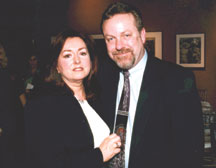|

SI
Educators Discover the Familiar at Ellis Island
By
Kahdeidra Martin and Katarzyna Kozanecka
Some
30 Staten Island school officials became threads in our nation’s
fabric recently by exploring the Ellis Island Tapestry, an interactive
curriculum that teaches history and social studies through drama.
Led by Kathleen Gaffney, co-founder and president of Artsgenesis,
Inc. who designed the Tapestry, participants used their imaginations
to leap back in time, becoming the daughters, husbands and disabled
grandmothers of families who migrated to the United States on
the busiest day in Ellis Island history: April 17, 1907. On this
day, 11,745 people were processed for citizenship.
From those first refugees who fled religious hegemony in England
to children of Sierra Leone, spared only their lives amidst the
war and famine infecting their paradise, the continuous migration
to America—North, South and Caribbean—is perhaps the largest of
the modern world.
“Migration
has always been part of the history of the world,” said Gaffney
to participants of the District 31 Principal’s Leadership Institute,
“yet it is [driven by] the individual choice of people who said,
‘This isn’t good enough; I am going here.’” At this professional
development workshop, Gaffney and Christopher Eaves, an artist
and educational designer for Artsgenesis, trained school officials
to “stimulate the multiple intelligences” in their students by
using arts-integrated curriculum. Moreover, officials experienced
the Tapestry for themselves.
First, the school officials were randomly divided into families.
Next, each group explored the Ellis Island Museum in order to
create their own family history. As the curriculum draws from
several primary documents, officials were told to choose a surname
from the Great Wall of Honor on the first floor of the museum.
Next, each person chose their gender, age, and ethnicity as well
as an occupation and a reason for immigrating to the United States.
To gain the most from the experience, Gaffney encouraged principals
to become someone of a completely different background. She said,
“ When you take the journey in the shoes of someone different
than yourself, you will awaken to things that [had previously
been] invisible to you.”
When the identification process was completed, Gaffney and Eaves
acted as immigration officers who decided the fates of each family.
Some members were admitted, others were sent to the hospital,
and still others were deported.
The Tapestry offers students a subjective account of history that
will accelerate learning. The curriculum’s success lies in its
loose framework and simple ideology. Primarily, the flexible structure
offers enough guidance without stifling teachers’ own creative
juices. Schools can opt to have a professional artist administer
the Tapestry. However, the goal of the workshop is to encourage
teachers to lead the workshop in the classroom or at a visit to
the museum. Dorothy Ambrosino, principal of PS 21, appreciates
the structure the Tapestry lends to a trip to the Ellis Island
museum because students are given a concrete but creative task
to complete. According to Julie Sherwood, principal of PS 23,
“It teaches team-building and social skills.” Indeed, the dramatic
workshop has several advantages. Through role-play, students will
make personal investments that ignite specific emotions of hope
and fear, excitement and grief.
“When
a human being learns something new, a new synapse grows in the
brain,” Gaffney said, “In the presence of strong emotions, such
as those unleashed by the arts, the synapse that grows is larger.”
Moreover, people learn better with an arts-integrated task because
they use multiple senses. Thus, musical, dramatic and visual arts
serve as catalysts for imparting various types of knowledge and
uncovering talents that a child may never had known existed. Gaffney
said, “The kids that are avoided, pestered, or persecuted will
get involved. The dynamics of your classroom will change incredibly.”
Augusta Mitchell, who played a duplicitous sister-in-law and is
principal of P.S. 29, said she “will definitely use the model”
in her school because “It’s marvelous, and it’s do-able.” Peering
at the photo of a seated Mr. Charles Petunia before he left the
British West Indies in 1918, she smiled and said, “He looks familiar.”
Education Update, Inc., P.O. Box 20005, New York, NY 10001. Tel:
(212) 481-5519. Fax: (212) 481-3919. Email: ednews1@aol.com.
All material is copyrighted and may not be printed without express consent of
the publisher. © 2001.
|

